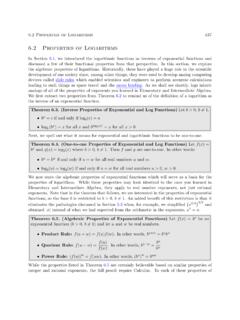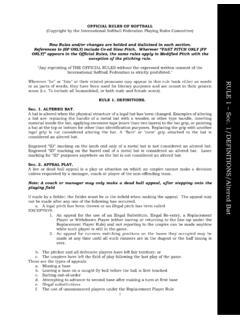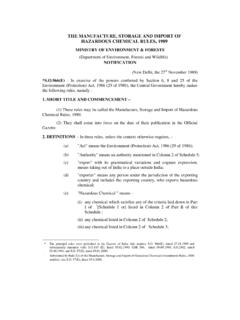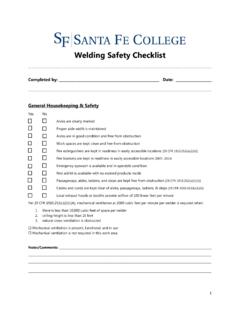Transcription of Laying Out Sector Angles for the Track & Field Throwing Events
1 Laying Out Sector Angles for the Track & Field Throwing Events Rev. , 5 SEP 12. Shot Put, Discus, Hammer & Weight Throw Sector Angle B. The shot, discus, hammer &. weight throw Sector is . A B. This angle was chosen due to its simple geometry. 50 ft 30 ft Create two Sector hairlines (using a tape measure or 60 ft 36 ft string) of length A that start at the center of the circle. The A A other ends of the Sector lines 100 ft 60 ft are separated by the distance B as given in the table at right. The distance B goes 150 ft 90 ft straight across; it is not curved.
2 175 ft 105 ft In short, B is 60% of any length of A . 200 ft 120 ft Note: see Page 8 before painting the Sector lines. X ( )*X. 2. Javelin Throw Sector Angle B The javelin Sector is . This A B angle resulted from constructing the Sector lines from the Foul Arc Center Point thru the ends of the runway 150 ft 75 ft sidelines. However, the Sector lines should not be actually drawn this way in the Field because many javelin 175 ft ft runways (mostly high school) are not the required 4 meters wide. Instead, use the following method: A A 200 ft 100 ft Create two Sector hairlines (using a tape measure or string) of length A.
3 Foul 250 ft 125 ft that start at the Foul Arc Center Point. arc The other ends of the Sector lines are separated by the distance B as X ( )*X given in the above table. The distance B goes straight across; it is not curved. In short, B is 50% of any length of Foul Arc Center Point, A . 8 meters (26' 3 ) behind the inside of the foul arc Note: see Page 8 before painting the (aka the pull-thru point ). Sector lines. 4 meter runway width 3. Laying Out & Adjusting the Sector Lines B. Ideally, three people will be available to lay Y Z out the Sector lines, located in positions X, Y.
4 And Z. Stretch out the measuring tapes or strings so that they are straight & taut, with the correct A and B lengths. The person in position X will then direct Y. and Z to the left or right, in unison, to center A A the Sector on the Throwing circle or runway: For shot put, the centering should be done on the stopboard. For discus, hammer and weight, the centering can be done relative to the circle dividing lines or the opening of the Throwing cage, whichever is more symmetrical and easier to measure from. X For javelin, the centering should be done on the points where the foul arc intersects the runway sidelines.
5 4. Laying Out & Adjusting the Sector Lines (con't). B. Y (Z) An alternate layout method can be used when less than three people or measuring tapes are stake available. Stretch out one tape (green line at left), as before, from the center of the circle to Point Y. Place a stake or old screwdriver in the ground at Point Z (also distance A from the center of A A the circle). Run the second measuring tape (blue line). from the center of the circle, around the stake and to Point Y. The tape should read the distance of A+B at Point Y. The final alignment will take a bit longer, as the stake may have to be reset once or twice by X the person at position Y to get the correct lengths of A and B of the blue line.
6 5. Painting the Sector Lines The heavy black lines shown here are the Sector hairlines which are determined by a tape measure or a string. The white stripes are always painted to the OUTSIDE. of the hairlines. They are 5 cm (2 inches) wide. Because the white stripes are outside the hairlines, they mark the start of foul territory. Note: The Sector lines are not painted within the circle or the runway. 6. Sector Angle Tolerance Of all the major T&F rule books, only USATF specifies a Sector angle tolerance for the circle throws. Rule states, Sectors shall be degrees ( degree).
7 There is no tolerance specified for the javelin Sector angle, although the standard would be reasonable to use. The following table converts to inches for various distances: B. Sector Cross- Tolerance of length A distance B distance B. (ft) (ft) (inch). 50 30 100 60 A A. 150 90 . 200 120 250 150 300 180 7. Sector Line Errors (seen in the Field ). With a narrow runway (<4 m), the Sector angle will be less than if the Sector lines are drawn thru the intersections of the foul arc and sidelines Sector angle is greater Incorrect Sector line termination than (due to using an old rule book or incorrect layout).
8 Or less than . (due to incorrect layout). runway width is 8. LESS than 4 m Some History The Throwing Events had no Sector lines in the early 1900s. Instead, the shot, discus, weight and hammer were simply thrown from a circle. By 1913, the new IAAF rule book mandated 90 sectors for hammer and discus, but no sectors for shot put or the weight throw. The javelin was thrown from behind a scratch line, properly marked. The 1914 IAAF rule book further defined the javelin scratch line as a 12' x 3 board, but no Sector or runway were specified. Eventually, sectors were introduced for all the Events thrown from a circle.
9 Over time, the Sector angle was reduced for safety purposes and to encourage more disciplined Throwing . The IAAF made the last Sector angle change for the circle throws in 2003, reducing it to . USATF matched that in 2003; NCAA followed suit in 2004, and NFHS in 2007, creating a Sector angle that is identical everywhere. The javelin runway and Sector angle, , were introduced in about 1951. They have remained unchanged since that time. 9. As an example of how the rules have changed, the following is a chronology of Sector Angles as specified by the NCAA rule books: Year Shot Discus Hammer Weight 1922 none 90 90 --- 1935 none 90 90 none (1).
10 1956 (2) 90 90 90 . 1958 or 59 (2) 60 60 60 . 1973-75 45 45 45 45 . 1979 40 40 40 40 . 2004 . (1) The weight throw event was introduced in 1935, but no Sector was specified. (2) The sectors coincided with the outer edges of the stop board. The NCAA adopted the IAAF definition of the runway and its Sector in either 1951 or 1952. It has not changed since then. 10.









